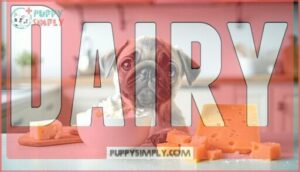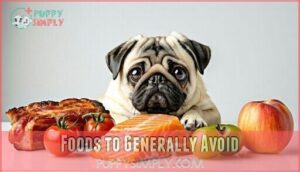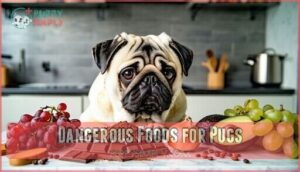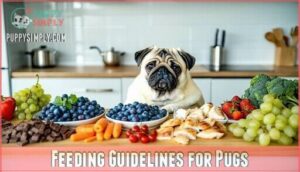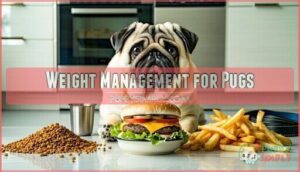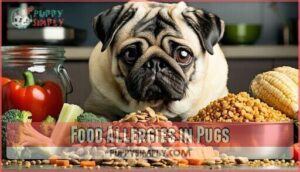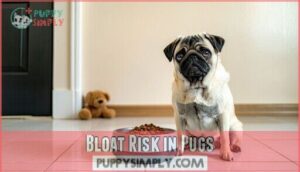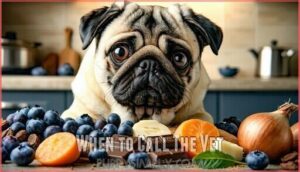This site is supported by our readers. We may earn a commission, at no cost to you, if you purchase through links.
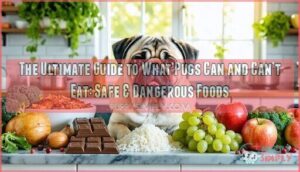 Feeding your pug can be tricky because their adorable little faces don’t come with a food manual!
Feeding your pug can be tricky because their adorable little faces don’t come with a food manual!
Safe bets include lean meats, cooked veggies, fruits like apples (no seeds), and plain rice.
But some foods need caution. Dairy and nuts are fine in tiny amounts (just watch for tummy troubles), while chocolate, onions, and grapes are downright dangerous.
Avoid toxic snacks like coffee, alcohol, macadamia nuts, and avocado—they’re pug kryptonite.
Keep meals balanced and treats occasional to avoid weight woes. Curious about homemade meals or managing allergies? There’s plenty more to uncover in the ultimate guide to what pugs can and can’t eat!
Table Of Contents
- Key Takeaways
- Safe Foods for Your Pug
- Foods to Eat in Moderation
- Foods to Generally Avoid
- Dangerous Foods for Pugs
- Feeding Guidelines for Pugs
- Weight Management for Pugs
- Making Homemade Meals
- Food Allergies in Pugs
- Bloat Risk in Pugs
- When to Call The Vet
- Frequently Asked Questions (FAQs)
- What food are Pugs most allergic to?
- What is the best diet for a Pug?
- What meat can Pugs eat?
- What Pugs can and can’t eat?
- Can Pugs eat bananas?
- Can Pugs eat chicken and rice?
- Can pugs eat watermelon without seeds?
- How often should pugs drink water?
- Are pug puppies nutritional needs different?
- Can older pugs eat soft kibble?
- Conclusion
Key Takeaways
- Stick to lean meats, cooked veggies, and safe fruits like apples (without seeds) as the foundation of your pug’s diet.
- Avoid toxic foods like chocolate, onions, grapes, alcohol, and macadamia nuts—they’re dangerous for your pug.
- Treat your pug in moderation with foods like cheese or peanut butter, but double-check for ingredients like xylitol that can be harmful.
- Watch for common food allergens like chicken, beef, and dairy, and consult your vet if your pug shows signs of itching or digestive issues.
Safe Foods for Your Pug
Your pug’s health thrives on the right diet.
Lean proteins like chicken, turkey, and fish are essential for muscle growth without the extra calories. Safe vegetables such as carrots, green beans, and broccoli pack in vitamins while keeping things light.
Lean proteins and veggies fuel your pug’s health—because every wag of their tail deserves the best nourishment!
For a touch of sweetness, fruit treats like blueberries or apple slices (seedless) are perfect. Cooked eggs provide quality protein, and plain yogurt helps with digestion.
Always introduce new safe foods for pugs gradually—because your little snorter deserves the best pug nutrition!
Foods to Eat in Moderation
Some foods are safe for your pug but should only be given in small amounts to avoid tummy trouble.
Even tasty treats like cheese or peanut butter need limits, or your pug might end up waddling instead of walking!
Dairy
Your little companion might love a cheesy nibble, but dairy can be tricky for pugs with lactose intolerance.
Digestive discomfort like dog gas or diarrhea is common, so moderation is key.
Stick to safer options:
- Plain yogurt for probiotics and tummy health
- Cottage cheese, a mild protein boost
- Cheddar, low in lactose but check the sodium
- Avoid milk alternatives with additives
- Watch out for bloating after dairy
Serving sizes should always be small.
Aim for happy tummies, not moody stomaches!
Nuts
Nuts can be a tricky treat for pugs. While some are safe, others are downright dangerous. Safe nuts, like unsalted peanuts, cashews, pine nuts, pistachios, and hazelnuts, can offer nutrients like protein and healthy fats.
But don’t go overboard—pugs don’t need many to enjoy the benefits. On the flip side, macadamia nuts are toxic foods for dogs and can cause tremors, weakness, or worse. Avocado, another common snack, also makes the no-go list for its harmful persin content.
Always be cautious with nut allergies; if your pug scratches excessively or has an upset stomach after eating nuts, stop immediately. When preparing nuts, stick to plain, unsalted, and unshelled options. And if peanut butter is on the menu, double-check for xylitol—it’s deadly for dogs.
As for serving sizes, think small—a few crushed nuts as an occasional treat will do the trick!
Chocolate
Chocolate might seem like a harmless treat, but for pugs, it’s a serious health hazard. The culprit? Theobromine—a compound their bodies can’t break down, making chocolate one of the most toxic foods for pugs.
Chocolate is a danger zone for pugs—theobromine toxicity can turn a tiny treat into a major health emergency.
Dark chocolate and baking chocolate are the worst offenders, packing the highest levels of theobromine. Even a tiny amount can cause chocolate toxicity. Symptoms like vomiting, diarrhea, excessive thirst, restlessness, or an elevated heart rate often appear within 6-12 hours. In severe cases, seizures or even death can occur. For a small pug, just one ounce of dark chocolate could be deadly.
If your pug eats chocolate, act fast. Call your vet immediately—they may induce vomiting or provide emergency treatment.
Want safe alternatives? Try these:
- Carob treats: Chocolate-like flavor without the danger.
- Homemade snacks: Use ingredients like banana or pumpkin.
- Dog-safe peanut butter: A tasty, pug-approved option.
Foods to Generally Avoid
Sharing food with your pug can be tricky, as some everyday items are downright dangerous.
Fatty foods like bacon or fried snacks strain their organs and lead to obesity. Raw fish and fat trimmings? Big no-nos—they can cause digestive issues or even pancreatitis.
Watch out for raw potatoes and green tomatoes; they contain toxic chemicals harmful to dogs. And peach pits? They’re a choking hazard and toxic.
- Fatty foods: Strain organs, cause weight gain.
- Raw fish: Can harbor parasites.
- Green tomatoes/raw potatoes: Contain harmful toxins.
- Peach pits: Toxic and risky to swallow.
Stick to safe, pug-approved treats!
Dangerous Foods for Pugs
Some foods that seem harmless to you can actually be dangerous for your pug.
Knowing what to keep off their plate can save you from an unexpected trip to the vet.
Coffee
That morning brew might perk you up, but it’s no treat for your pug.
Coffee contains caffeine, a culprit behind heart racing, nervous system damage, and even seizures in dogs.
Just a sip can trigger caffeine toxicity, making it one of the most dangerous foods for pugs.
Instead of sharing, stick to pug-safe options like fresh water or low-sodium bone broth.
Keep coffee grounds and mugs far from curious snouts!
Alcohol
Alcohol is no joke regarding pugs—it’s one of the most dangerous foods they can encounter.
Even a tiny sip can cause:
- Neurological effects like confusion, tremors, or seizures.
- Liver damage, which can be severe even with small amounts.
- Respiratory failure, leading to life-threatening situations.
- Alcohol poisoning, requiring immediate action and veterinary care.
Keep alcohol far away from your pug—it’s simply not worth the risk.
Macadamia Nuts
Macadamia nuts rank high on the list of toxic foods for pugs.
Even a tiny amount can trigger dog poisoning, causing symptoms like muscle tremors, weakness, vomiting, and a feverish spike in body temperature.
The exact toxicity levels or why pugs react this way isn’t fully understood, but the risks are real, and if accidental ingestion happens, call your vet immediately for assistance, as it is a serious situation that requires immediate attention.
Instead, stick to alternative nuts like unsalted peanuts for safer snacking.
Avocado
Avocado is a no-go for your pug! Packed with persin, it’s one of the most toxic foods for dogs, causing vomiting, diarrhea, and serious health issues.
Even a small bite isn’t worth the risk. Instead, try avocado alternatives like blueberries or carrots—they’re pug-friendly and packed with nutrients.
Keep your pug’s diet safe, and their tail will keep wagging!
Feeding Guidelines for Pugs
Feeding your pug isn’t just about filling their bowl; it’s about creating a routine that keeps them healthy and happy.
Stick to small, balanced meals and limit treats so they don’t start waddling like a furry little penguin!
Meal Frequency
After learning about foods to avoid, let’s talk about how often your pug should eat. A proper feeding schedule is like a roadmap for their health—especially with their tendency to pack on pounds.
Stick to 2-3 small meals daily to support digestion and maintain energy. Consistent meal times help regulate their metabolism and keep their internal clock ticking smoothly. Portion control is your secret weapon against obesity, so skip the free-feeding.
Here’s a quick pug feeding guide:
- Puppies need 3 meals daily to fuel growth.
- Adults thrive on 2 meals to balance activity and rest.
- Seniors benefit from smaller, frequent meals for easier digestion.
Healthy eating equals a happy pug!
Treats
In the context of dog treats, your pug’s excitement can be contagious, but treat size matters.
Stick to dog treats moderation, keeping them under 10% of daily calories. Healthy pug treats like small apple slices (skip the seeds!), baby carrots, or cooked chicken bits are excellent training treat rewards.
Consider browsing a site for various pug training treats if you need more options.
Want to try homemade pug treats? Freeze plain yogurt into small drops – they’re cooling, tasty, and a fun safe food option!
Reputable Brands
Picking the right food for your pug isn’t a gamble—stick with reputable brands suited to their unique needs.
Look for options with excellent ingredients and vet recommendations.
- Royal Canin Pug Adult: Ideal for breed-specific nutrition.
- Wellness CORE Small Breed: Grain-free with excellent nutritional value.
- Fromm: Great for sensitive stomachs.
- Merrick Lil’ Plates: High-quality formulas for small breeds.
- Spot & Tango UnKibble: Balanced, fresh meals for your pug’s diet.
Consider exploring options for breed-specific nutrition needs for your pug.
Choosing carefully guarantees your pug’s health stays superior!
Weight Management for Pugs
Pugs are charming companions, but their love for food can lead to pug obesity if you’re not careful.
Keeping your furry friend within the healthy weight range of 14-18 pounds is key to avoiding health issues tied to dog obesity.
To improve pug weight management, focus on balanced meals, portion control, and activity.
Use a measuring cup for precise portions, and feed smaller, frequent meals to support metabolism.
If your pug needs to shed pounds, aim for a slow, steady weight loss of 0.5-1% per week.
Exercise matters too—pugs may be small, but they still need 40-60 minutes of gentle activity daily.
A short walk or a quick play session keeps them active and healthy.
Making Homemade Meals
Take charge of your pug’s health with homemade meals. Start strong with fresh, lean proteins—chicken, turkey, and beef work great.
Add pug-friendly vegetables like carrots, broccoli, or zucchini for balance. Complex carbs like quinoa or rice are exceptional fuel.
Cooking methods? Keep it simple—thoroughly cook meats and soften veggies by steaming or boiling. Consider chewy options for dental health.
Portioning strategies matter; small meals suit their little tummies. Rotate pug food ingredients weekly to keep things interesting and nutritious. It’s customized dog nutrition wrapped in love!
Food Allergies in Pugs
Food allergies can make your playful pug feel downright miserable. When discomfort sneaks in, it’s time to dig into detective work.
Common allergens like beef, chicken, wheat, and corn often turn into troublemakers. And the symptoms? They’re hard to miss:
- Itching Frenzy: Watch for relentless scratching, especially on the ears, paws, or belly.
- Digestive Drama: Vomiting, diarrhea, or room-emptying gas spells could hint at food allergies.
- Skin Struggles: Redness, hot spots, or rashes can suddenly appear overnight.
If your pug shows these signs, your vet might suggest an elimination diet to pinpoint culprits. Eliminating triggers and switching to hypoallergenic food helps manage allergies and keeps your pug comfortable.
Keep a food journal—it’s like a detective’s notebook. Note meals, treats, and every reaction. It’ll help you spot and avoid those pesky allergens hiding in your pug’s diet.
Bloat Risk in Pugs
Your pug’s cute shape makes them prone to bloat, a serious digestive issue.
To keep their stomach happy, follow these tips:
- Elevated Bowls: Reduce air swallowing during meals.
- Slow Feeders: Control their eating speed and prevent gulping.
- Meal Size: Serve smaller portions throughout the day.
- Exercise Timing: Wait 30-60 minutes after meals before playtime.
Think of dog digestion like traffic—it moves better without a sudden rush! Keeping their posture right and meals controlled guarantees better pug digestive health.
When to Call The Vet
When your pug isn’t acting like their usual playful self, it’s normal to worry. Knowing when to call the vet could save your furry friend’s life.
Keep an eye out for serious symptoms like sudden vomiting, bloody stool, or breathing difficulty. If you think they’ve had toxic ingestion of chocolate, onions, or other dangerous foods, don’t wait—call an emergency vet immediately.
Other red flags include:
- Refusing food or water for over 24 hours
- Unexplained weight loss or extreme lethargy
- Signs of pain like whining, shaking, or avoiding touch
- Swelling, hives, or excessive scratching that suggests food sensitivities.
Sometimes your pug’s symptoms are mild but still troubling. Trust your instincts; you know them best. Whether it’s questions about dog allergies or general dietary advice, a quick call can prevent small issues from becoming emergencies. Better safe than sorry!
Frequently Asked Questions (FAQs)
What food are Pugs most allergic to?
Watch out for foods like grains, chicken, beef, eggs, and dairy—these often trigger allergies in pugs.
Symptoms include itching, ear infections, or tummy trouble.
Always monitor meals and consult your vet for clarity.
What is the best diet for a Pug?
A balanced diet for your pug includes lean proteins, cooked vegetables, and healthy grains.
Incorporate small amounts of fruit for treats.
Avoid overfeeding—pugs love food and can gain weight faster than you can say "snack!
What meat can Pugs eat?
Ever wondered what makes your Pug’s tail wag?
Cooked meats like chicken, turkey, beef, and lamb are perfect.
Keep them plain, boneless, and unseasoned.
Avoid cured meats, though—too much salt isn’t their friend!
What Pugs can and can’t eat?
You’ve got plenty of safe options like cooked chicken, carrots, and apples (seeds removed).
Avoid chocolate, grapes, or onions—they’re toxic.
Moderation matters; even safe foods in excess can upset their tiny, sensitive tummies.
Can Pugs eat bananas?
Bananas? They’re like nature’s candy for your pug!
Packed with potassium and fiber, they’re a sweet treat.
Just slice them up small and avoid overfeeding—too much could upset their tummy or add extra calories.
Can Pugs eat chicken and rice?
Yes, pugs can eat chicken and rice.
It’s a simple, digestible meal great for upset tummies.
Just cook the chicken plain, avoid bones, and serve rice without seasoning.
Think of it as pug comfort food!
Can pugs eat watermelon without seeds?
Sure, pugs can enjoy seedless watermelon as a delightful treat.
Just remove all the seeds and rind first.
It’s hydrating and sweet, but don’t overdo it—too much can upset their tiny tummies!
How often should pugs drink water?
Your pug should always have access to fresh water.
They need small, frequent sips throughout the day, especially after playtime or meals.
Think of them as tiny hydration bosses—always thirsty, never dramatic.
Are pug puppies nutritional needs different?
It’s like feeding a growing athlete—pug puppies need more protein, healthy fats, and calories than adults to fuel their rapid growth.
Their meals should include nutrient-dense food formulated to their energy and development needs.
Can older pugs eat soft kibble?
Older pugs can enjoy soft kibble, especially if they’ve dental issues.
It’s easier to chew and gentle on aging teeth.
Just make sure it meets their nutritional needs—because everyone deserves tasty, healthy meals!
Conclusion
Feeding your pug might feel overwhelming, but now you’ve got the ultimate guide to what pugs can and can’t eat.
Remember, their health depends on you knowing the difference between safe treats and toxic snacks.
Stick to lean meats, veggies, and fruits, but always avoid pug kryptonite like chocolate, grapes, and macadamia nuts.
Balance meals carefully, keep treats occasional, and watch for allergies or bloat.
When in doubt, ask your vet—it’s better to be safe than sorry!

